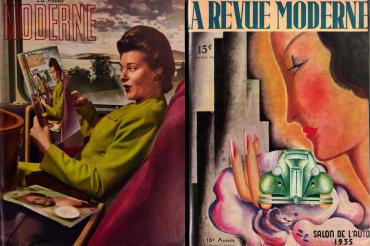Literature, politics, art: How an early French-Canadian magazine helped shape literary culture

La Revue moderne was a general-interest monthly magazine that targeted a mainly a female audience and became French Châtelaine after it was purchased by Maclean-Hunter (images supplied by Adrien Rannaud)
Published: December 7, 2021
In his new book, La révolution du magazine au Québec, the University of Toronto’s Adrien Rannaud demonstrates how one of Quebec’s first magazines reflected and advanced literature and culture from 1919 to 1960 – and how its impact is still evident today.

“This publication, called La Revue moderne, was an ideal starting point for examining the ways that magazines can shape literature,” says Rannaud, an assistant professor of French Studies at U of T Mississauga’s department of language studies.
His research focuses on 19th- and 20th-century Quebec literature, women’s writing, celebrit
y culture and middlebrow literary culture. In all of these areas, he says, studying magazines can be illuminating.
The book’s title refers to how the advent of magazines in the 20th century revolutionized print media.
“Unlike newspapers, magazines were freed from the pressure of reporting on day-to-day news,” he says. “They used images and design to present information in new ways. And they invited readers to take time for themselves to escape from reality, especially with fiction and poetry.”
In the book, written in French, Rannaud notes that English magazines such as Chatelaine, Mayfair and Canadian Home Journal – which co-existed with La Revue moderne – had similarly important roles in the literary world.
“French-Canadian magazines just haven’t received as much academic attention or systematic study as anglophone ones, or as magazines in France,” he says.
La Revue moderne’s founder, who wrote under the pseudonym “Madeleine” and whose real name was Anne-Marie Huguenin, was a celebrity in Montreal’s high society. She wrote for one of the city’s leading newspapers and became known as the “queen of the chronicle.” By the end of the First World War, Rannaud says, she wanted a bigger vehicle to showcase not just her own writing, but that of her fellow up-and-coming young francophone writers.
In the magazine’s first editorial, she laid out her intention to deliver a literary, political and artistic (the three words below the masthead) publication that would “brilliantly attest to the value of our poets [and] writers.” While the magazine was well-received in some circles, its lofty ambitions – and female leadership – didn’t sit well with the male social elite and clergy, says Rannaud. “She was outspoken about her goal of uniting francophone and anglophone culture, and there were a lot of articles that were quite political. It was difficult for a woman in the 1920s to lead an intellectual magazine. She was subject to a lot of anti-feminism.”
The external pressures, combined with commercial necessities, drove Madeleine to shift La Revue moderne’s emphasis away from political and other “serious” content to subjects considered appealing to women. “By around 1922, there were more advice columns, recipes, coverage of society events, and fiction and poetry,” says Rannaud.
It was in this last category, he argues, that La Revue moderne had the most profound effect on Quebec’s cultural history.

The magazine launched the careers of many authors, poets and writers, including one of the most famous French Canadian authors: Gabrielle Roy, the author of The Tin Flute and other books. One of her first publications was in La Revue moderne. “Quebec isn’t known for avant garde, or highbrow, literature, but it has a thriving popular culture and literature,” says Rannaud. “La Revue moderne helped cultivate that literature by bringing it to a large audience and inspiring other young writers.”
Beyond its significant shaping influence on literature, the magazine kept pace with changing trends in the broader culture. By the 1940s, women’s rights and celebrity news began to take a prominent place in the magazine. The content also became highly interconnected with radio and television culture, featuring articles on the best and latest programs to listen to and watch.
“The profiles on celebrities and attention to other media were, in some ways, very current,” says Rannaud. “These are things we see everywhere in magazines in 2021. So while La Revue moderne was very old-fashioned in its depiction of women, domestic life and relationships, it also helped pave the way for contemporary publications.”
In 1960, Maclean-Hunter bought La Revue moderne and it became French Châtelaine magazine. The new publication built on the original’s cultural and literary foundations, says Rannaud, pointing to the ongoing tradition in several Canadian magazines of authors publishing short stories and book excerpts.
“Without the revolution La Revue moderne participated in, we wouldn’t have the strong relationship between literature and magazines that we have today.”



